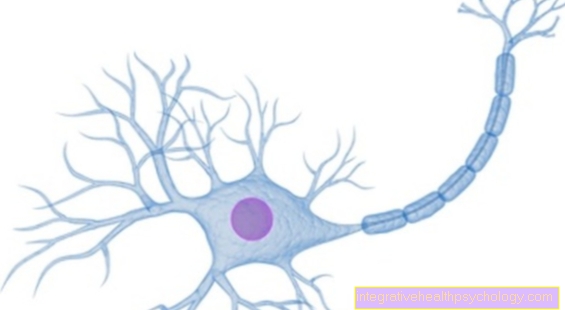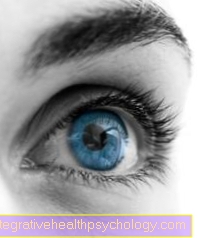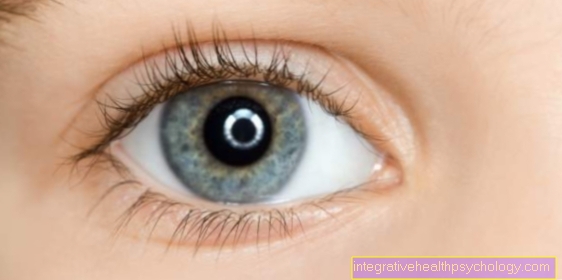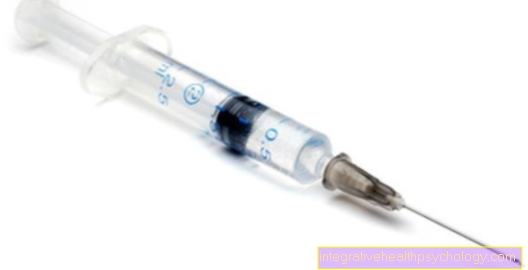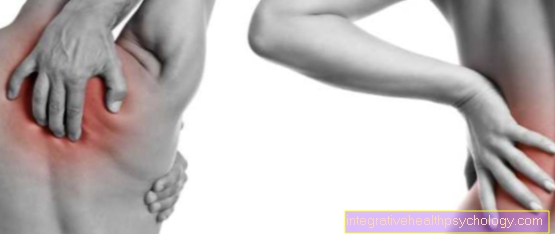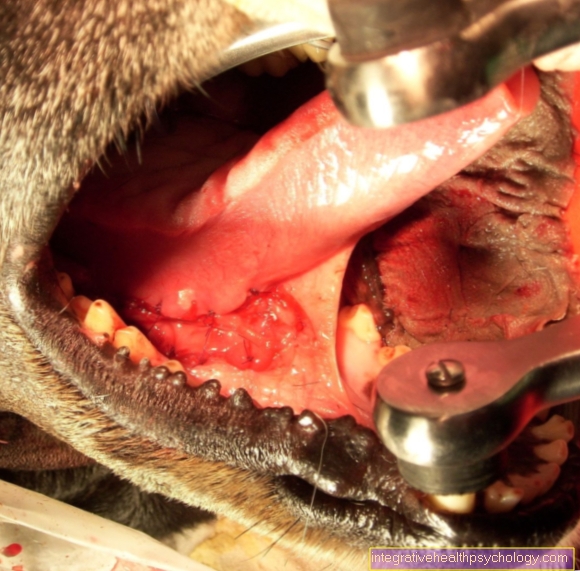Inflammation of the trigeminal nerve
introduction
The so-called inflammation of the trigeminal nerve is actually trigeminal neuralgia and is only mistakenly referred to as "inflammation". It is a very painful disease of the fifth cranial nerve (Trigeminal nerve). The nerve comes directly from the brain, runs in the face and supplies the skin there sensitively. It is also responsible for the function of the jaw muscles. The inflammation usually affects the lower two thirds of the face, which is due to the division of the trigeminal nerve (German: trigeminal nerve) into its three main branches.
If you want to learn more about the anatomy of the nerve read here: Trigeminal nerve
Read more on the subject at: Inflammation of the facial nerves

Symptoms
An inflammation of the trigeminal nerve causes extremely strong, attack-like pain, which often reaches the highest level on the pain scale (Level 10). This pain typically comes on very suddenly and lasts only a few seconds. However, the attacks can occur very frequently, sometimes more than 100 times a day.
The pain can usually be provoked, especially by touching the nerve supply area (so-called tactile stimuli) such as on the cheek or chin. Chewing while eating can also trigger attacks in many patients.
Since the pain is extremely strong, there is also great suffering for the person concerned. It is not uncommon for the pain to even lead to severe depression, with all of the associated consequences.
Pain
The pain associated with trigeminal inflammation is often described as very strong and stabbing ("lancing"). Since the trigeminal nerve is responsible for the sensitivity in the face, touch can also trigger pain attacks here. In severe cases, a small breeze is enough to trigger such a lightning-like pain attack, which then lasts a few seconds. At the beginning of the illness, those affected are usually pain-free between such attacks. However, if there is no adequate therapy, the pain can become chronic and lead to constant dull pain. If such pain occurs, you should see your family doctor or even better a neurologist as soon as possible so that the cause can be eliminated and the pain treated.
Read more on the subject below Inflammation of the facial nerve.
Toothache with inflammation of the trigeminal nerve
The main task of the trigeminal nerve is the sensitive supply of the face and teeth. If there is pronounced damage in the course of the nerve, which is accompanied by severe pain, this pain sensation can spread to the other sensitive structures of the nerve area, since the brain can no longer distinguish where the source of pain really lies. This can result in severe toothache, among other things. A good attitude with appropriate painkillers, especially anti-epileptics and antidepressants, is essential.
Read more on the subject below Pain relievers for toothache.
Headache with inflammation of the trigeminal nerve
An inflammation of the trigeminal nerve very often leads to radiation to other areas of the supply area of the trigeminal nerve, which in some cases also includes the meninges. In many cases, side effects such as toothache, extreme sensitivity of the skin or headache are part of the clinical picture. In most cases, the headache is described as stabbing and pulling. Attempts to relieve the pain with conventional headache medication such as aspirin or ibuprofen are usually unsuccessful, since nerve pain (so-called neuropathic pain) cannot be treated with these.
Earache with inflammation of the trigeminal nerve
Trigeminal neuralgia is associated with severe pain in almost all cases. Since the main function of this nerve is the sensitive supply of many structures in the head area, this pain can also spread to these other areas, such as the ear.
This is due to the fact that the brain cannot distinguish whether the pain stimulus really comes from the ear or whether the nerve is only inflamed in the course of the process and this is what triggers the pain stimuli. Many patients with trigeminal inflammation report severe pain in the ears, which can be exacerbated by loud noises.
diagnosis
Inflammation of the trigeminal nerve does not always have to be the cause of severe facial pain when touched or when chewing and speaking. For this reason, the diagnosis of inflammation of the trigeminal nerve should always be made based on several criteria.
Other diseases that can be considered with similar symptoms include, for example, cluster headaches, so-called idiopathic facial pain, inflammation or injuries to the teeth, eyes or sinuses, and jaw problems.
In order to be able to differentiate these diseases from real trigeminal neuralgia, a detailed patient consultation takes place, in which the attending physician asks about the acute symptoms and tries to rule out other diseases by asking specific questions.
Diagnostically, one can also distinguish between two forms of trigeminal neuralgia. For this reason, an imaging procedure is usually used - magnetic resonance tomography (MRI). With the help of the images that are made in the MRI, the cause of the occurrence of the neuralgia can be found out and, if possible, a suitable therapy can be initiated.
A distinction is made between the so-called classic trigeminal neuralgia, in which an unusual course of a blood vessel presses on the trigeminal nerve and thus causes the pain, and what is known as symptomatic trigeminal neuralgia, in which the symptoms are based on another disease. Above all, multiple sclerosis or tumors in the brain stem are a possible cause.
This distinction is also important from a diagnostic point of view, as the therapy depends crucially on the respective cause.
causes
A distinction is made between classic or idiopathic trigeminal neuralgia and symptomatic trigeminal neuralgia. The difference is that in a symptomatic form, another disease is the cause of the existing symptoms.
The cause of the classic or idiopathic form is an unusual course of a blood vessel that destroys the nerves' isolation of the nerve, the myelin sheath, causing the nerve to become overly sensitive.
In symptomatic trigeminal neuralgia, various diseases can be considered as the cause. Inadequate nerve sheathing (destroyed myelin sheaths), e.g. in the context of multiple sclerosis or an insufficient blood supply to a nerve part of the trigeminal nerve, as can happen in a stroke. Benign, extensive tumors in the internal auditory canal (acoustic neuromas) can also be the cause.
Inflammation of the trigeminal nerve after a cold
In the case of a cold, the causative pathogens are often located in the area of the paranasal sinuses on the face. From here they can spread in different directions. Due to the spatial proximity, it can also spread in the direction of the trigeminal nerve.This can result in pain in the trigeminal region even days after a cold has subsided. While this is unusual, it can happen occasionally.
After a cold, the human body is often weakened. This means that the immune system is busy making the body more vulnerable and able to develop various symptoms more quickly. Therefore, a temporary pain in the trigeminal nerve area need not immediately be attributed to inflammation. Occasionally, however, the pathogens causing the common cold are very persistent and cause pronounced inflammation of the nerve. If the pain does not improve within several weeks or even gets worse, a doctor should be consulted.
Inflammation of the trigeminal nerve caused by herpes viruses
The term herpes viruses describes a group of viruses which they permanently establish themselves in certain nerve cells in the body and which can be reactivated by certain triggering factors such as stress or immune deficiency. The manifestations range from simple cold sores on the lip to pronounced shingles (Herpes zoster).
The viruses always spread via the affected nerves, which can lead to inflammation with typical symptoms on the skin. If this affects the trigeminal nerve, this leads to trigeminal inflammation, which is often associated with very severe pain. The focus of therapy is primarily on pain therapy and treatment with antiviral agents (e.g. acyclovir) to contain the herpes virus. A complete removal of herpes viruses from the body is unfortunately not possible here.
Inflammation of the trigeminal nerve from dental disease / dental treatment
Various tooth diseases can also be the cause of trigeminal inflammation. The second and third branches of the trigeminal nerve also supply the teeth. Therefore, infections that started on the teeth can spread towards the nerve and lead to inflammation there. Even small injuries to the trigeminal nerve itself, for example from an invasive dental procedure, can promote inflammation.
therapy
The therapy / treatment depends crucially on the type of inflammation. In the case of symptomatic trigeminal neuralgia, it is always sensible to treat the disease that is primarily responsible for the occurrence of the inflammation. In addition, suitable pain therapy is also useful so that these symptoms are improved.
In general, trigeminal neuralgia can be treated with medication, surgery or, more recently, radiotherapy.
Carbamazepine has long been the drug of first choice. Actually as an anti-epileptic (so with one Epilepsy) is very suitable for many patients to be able to control the symptoms of trigeminal neuralgia well.
Other drugs in this class of substances, such as phenytoin, also an anti-epileptic, are often used. In some cases, a local anesthetic is injected into the affected, painful nerve in order to at least temporarily prevent the perception of pain.
Depending on the symptoms and the individual course of the disease, surgical therapy may also be considered. There are several different methods to choose from. Basically, two different procedures must be distinguished here.
On the one hand, there are surgical procedures in which the skull bone has to be opened. If the skull bone is opened, parts of the trigeminal nerve can be obliterated using different methods. This surgical method is very successful, but can lead to complications, especially sensory disturbances in the face.
On the other hand, there are surgical procedures that do without opening the skullcap. There the nerve above the skull is treated. The success rate is good, although in some patients many symptoms return after a while. This type of operation is also not without complications and can also cause sensory disturbances in the face and in some cases lead to unilateral numbness.
Recently there has also been the option of treating trigeminal neuralgia with radiotherapy. In this method, part of the nerve is irradiated. The overall success rate is very good and is around 85% pain-free treated patients. Symptoms recede in some patients, with around 75% of irradiated patients still being pain-free after 3 years.
Medication for inflammation of the trigeminal nerve
One problem in the treatment of nerve pain is that "normal" pain relievers, so-called NSAIDs such as Aspirin® or ibuprofen, have no effect on them. Therefore you have to resort to other active ingredients.
Often will Anticonvulsants, so drugs from the therapy of epilepsy are used, and Antidepressants which also work for neuropathic pain, but they are usually given in lower doses than for their original purpose. It is believed that their effect is based on the inhibition of excessive nerve activity. In this way they prevent the pain stimulus from being passed on to the brain. If the nerve pain cannot be adequately treated with these drug groups, there is the option of using the very powerful opioids, which act centrally in the brain and prevent the transmission of pain stimuli.
Read our articles on this
- Medicines for epilepsy
- Antidepressants
- Opioids
Home remedies for trigeminal neuralgia
A very popular home remedy for trigeminal neuralgia is the use of a cold compress with lavender. For this purpose, some boiling water is poured over lavender flowers. The whole thing is left to stand for about 15 minutes, after which the flowers should be removed and the water cooled down to about 40 degrees. Now you can dip a linen towel in this infusion and hold it on the affected side of the face.
Cabbage leaves have also proven themselves in the treatment of neuralgia. Here you use fresh cabbage leaves, which are then rolled out with a rolling pin so that the liquid contained in them and thus the active ingredients escape. The cabbage leaves can now simply be placed on the half of the face with a compress around them. They have a calming and cooling effect.
Various oils can also be used as home remedies. For example, some swear by the camphor oil soaked in crushed garlic for about a week. This can be used to rub in the area where the pain occurs. Other oils that can help relieve the pain are clove oil, eucalyptus oil, and basil oil.
Heated linen bags filled with hay flowers can also help relieve pain.
Please also read our home remedies articles
- lavender
- Cabbage
- Fighter
Naturopathy and homeopathy for inflammation of the trigeminal nerve
The best-known herbal remedy for trigeminal neuralgia is the so-called St. John's wort (Hypericum perforatum). In addition to the treatment of nerve inflammation, this also finds its place in the therapy of depression.
However, it should only be taken after consulting a doctor, as St. John's wort influences various enzymes in the body and can therefore change the effect of other drugs. The phenomenon that antidepressants have the best effectiveness against nerve pain can also be observed in therapy with conventional drugs. Aranea diadema is another homeopathic remedy. This active ingredient obtained from cross spiders actually has a poisonous effect on nerves, but if the dose is well adjusted, it can also be used to treat nerve inflammation. However, it should only be used as part of a professional homeopathic therapy and not used by laypeople themselves.
In general, Arsenicum album (D6, D12, D30), Aconitum (C3, D4, D6) and Spigelia (D6, D12) are also considered well suited by homeopaths for combating nerve pain.
Read more on the subject below Johannis herbs.
frequency
Overall, inflammation of the trigeminal nerve is a condition which more often women than men concerns. It is also a disease that is more common in the elderly occurs. Such are most of the people who suffer from inflammation of the trigeminal nerve between 70 and 80 years old.
Overall, less than 0.05% of the population is affected by the disease, with around 3.5 (Men) and 5.9 (Women) fall ill for every 100,000 inhabitants.
Duration and forecast
The course of the disease of trigeminal neuralgia is progressive in about 2/3 of the cases. This means that the disease and its symptoms will continue to progress without therapy.
However, around 30% of those affected only experience a single episode and are cured after the symptoms have subsided.
The duration of trigeminal inflammation depends heavily on the cause of the inflammation and the response to treatment. If there is an acute inflammation of the nerve, the chances of a short duration with a complete cure are usually higher than in the case of a long-standing chronic inflammation. The latter can also turn into trigeminal neuralgia, for example.
There are very different testimonials from people who suffer or have suffered from an inflammation of the trigeminal nerve. For some, home remedies simply help to improve symptoms or even make them go away. Others suffer from the pain of trigeminal inflammation for years, especially as it develops into trigeminal neuralgia. In many patients, this can only be treated effectively with intensive drug therapy, but it often persists for a long time.
The individual doctor can best assess the course of the disease. A comprehensive discussion about therapy options and the associated prognosis of the disease should always be conducted with the treating specialist (neurologist).

.jpg)



